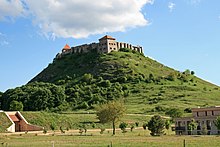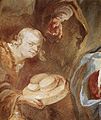Sümeg
| Sümeg | ||||
|
||||
| Basic data | ||||
|---|---|---|---|---|
| State : | Hungary | |||
| Region : | Central Transdanubia | |||
| County : | Veszprém | |||
| Small area until December 31, 2012 : | Sümeg | |||
| District since 1.1.2013 : | Sümeg | |||
| Coordinates : | 46 ° 59 ' N , 17 ° 17' E | |||
| Area : | 64.13 km² | |||
| Residents : | 6,226 (Jan 1, 2011) | |||
| Population density : | 97 inhabitants per km² | |||
| Telephone code : | (+36) 87 | |||
| Postal code : | 8330 | |||
| KSH kódja: | 25593 | |||
| Structure and administration (as of 2016) | ||||
| Community type : | city | |||
| Mayor : | László Végh (Fidesz-KDNP) | |||
| Postal address : | Béke tér 7 8330 Sümeg |
|||
| Website : | ||||
| (Source: A Magyar Köztársaság helységnévkönyve 2011. január 1st at Központi statisztikai hivatal ) | ||||
Sümeg ( German Schimeck , Croatian Šimeg ) is a town in western Hungary , southwest of the Bakony Forest , in Veszprém County . The town is best known for its castle .
geography
The city is located southwest of the Bakony Forest , in Veszprém County , 18 km north of Tapolca and 23 km north of Lake Balaton . Sümeg has a train connection from Vienna as well as Graz and Budapest . It is located on the branch line from Ukk via Tapolca to Keszthely and Balatonszentgyörgy .
history
The area around Sümeg was already settled in the Bronze Age . From this time there are burial sites, stone axes , funerary urns and other utensils. From the time of the Roman Empire , a Roman military camp (castrum) and Roman houses were found at the end of the 19th century . The finds are in the city museum.
In the 13th century, Sümeg Castle was built on a 270 m high limestone hill above the city. This castle has had military importance since the time of the Turkish Wars. When the strategic importance waned, the castle fell into disrepair.
In 1643 Sümeg received city rights . The city's economic output grew with it. This brought artisans and nobles to the city. A city wall was built as well as a monastery and a church of the Franciscan order . In 1700 a fire destroyed almost the entire city. It is said that only the Franciscan monastery and four brick houses have survived. For the subsequent reconstruction, it was imperative to only build stone houses within the city walls in order to prevent another fire.
In 1552 the bailiff's seat was moved from Veszprem, which was occupied by the Turks, to Sümeg, Bishop Biró Márton Padányi had the bishop's palace built 200 years later and called Franz Anton Maulbertsch to Sümeg, whose frescoes can be admired in the town's churches. This development brought scholars and writers to Sümeg. Baroque town houses along the former city walls bear witness to the development of the city at that time.
At the time of the Rákóczi uprisings , the castle played a military role again. In the period from 1703 to 1709 the castle was conquered by the rebels. In 1709 it was re-conquered by imperial Habsburg troops, set on fire in 1713 and 1726 and left to decay.
In the 19th century, Sümeg made a name for itself beyond Hungary as a place of wine trade. The entrepreneur Vince Ramassetter (1806–1878) built a winery and a trading company that sold his products across Europe. Other important Sümeger personalities in the field of viticulture were the sparkling wine pioneer Lajos Rosty (1769–1839) and the oenologist Ferenc Entz (1805–1877).
Culture and sights
The city's most famous attraction is the castle, which towers on a hill above the town. Today jousting games and various events take place in the renovated walls of the ruins.
Sümeg has also been a place of pilgrimage for 250 years . The statue of grace of the Blessed Virgin Mary in the Franciscan Church is visited every September. It is a seated figure of Mary ( Pietà ) carved out of wood, weeping for the body of her son. The adjacent Franciscan monastery, founded in the middle of the 17th century, was settled again by the Franciscan order in 1989 after an interruption during the communist era.
The parish church is located on Deák Ferenc Street, which was built in the late Baroque style in the mid-18th century . The frescoes inside the church were painted by Franz Anton Maulbertsch.
Another building in the Baroque style is the former bishop's palace ( Püspöki palota ) built in the 18th century . It is located on Szent István tér (St. Stephen's Square). The building, which was used as a boarding school during the communist era and was in ruins at the time, was renovated at the beginning of the 21st century and has served as a museum and exhibition space since 2011; In the cellars, which have also been renovated, there is a wine shop and tasting rooms.
The course of the former city wall can be seen in the streets of the city. A section of approximately 1 km has been preserved from the wall. There are several mansions in the city . The house where the poet Sándor Kisfaludy (1772–1844) died and was born on the church square was converted into a museum.
In 1960, a 5000 year old princely grave was discovered on the Mogyorós-Domb hill to the west of the city . This is accessible as an open-air museum .
To the south is the Ördögigafa beech.
sons and daughters of the town
- Sándor Kisfaludy (1772–1844), poet
- Josef Székely (1838–1901), photographer and chemist
Town twinning
-
 Sovata , ( Romania )
Sovata , ( Romania ) -
 Aichtal , ( Germany )
Aichtal , ( Germany ) -
 Tapolca , ( Hungary )
Tapolca , ( Hungary ) -
 Kościan , ( Poland )
Kościan , ( Poland ) -
 Vobarno , ( Italy )
Vobarno , ( Italy )
View of the city of Sümeg from Sümeg Castle
Ceiling fresco by Franz Anton Maulbertsch , 1785, Sümeg parish church
Web links
- Official website ( Hungarian )
- Sümeg in A Pallas nagy lexikona (Hungarian)








